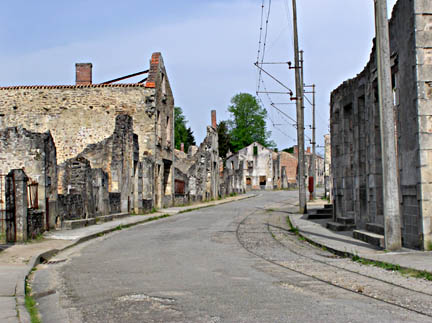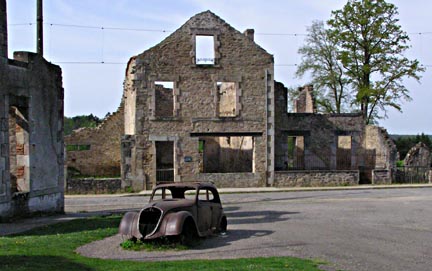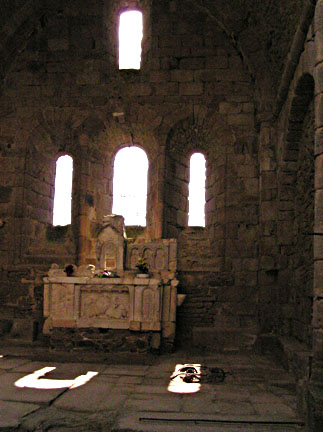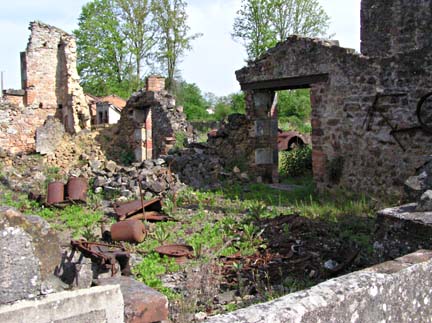|
 This village, located northwest of Limoge, was the site of a one day massacre on June 10, 1944. Its story is preserved as the government decided to leave the village as it was found. We visited the site in May, 2005. At right is the main street of the village. This village, located northwest of Limoge, was the site of a one day massacre on June 10, 1944. Its story is preserved as the government decided to leave the village as it was found. We visited the site in May, 2005. At right is the main street of the village.
At the time of the massacre, the Nazi’s were using fear and intimidation to keep the occupied populace in control. The high command of the German Wehrmacht had stated in 1941: “Commanders must find the means to impose order... by applying suitable draconian measures.... All resistance must be dealt with, not by pursuing the perpetrators but by the occupational forces instilling terror to such an extent that all vestiges of resistance are removed.” Further, Himmler stated in 1943 “We are well known for arousing fear and sowing terror. This is an extraordinary weapon and we must ensure it does not lose its power. On the contrary we must increase its potency.”
 T h e p o li tical views of the people in the area around Limoge were liberal and the French Resistance was very strong in this region. The SS division was attempting to sweep out the Resistance in the Tulle-Limoge area. The division had about 8500 troops and everywhere they went, there were massacres, pillaging and arson, designed to instill terror. It had been decided that an example needed to be made in this area to put down the Resistance forces. Oradour sur Glane was the culmination of the atrocities. T h e p o li tical views of the people in the area around Limoge were liberal and the French Resistance was very strong in this region. The SS division was attempting to sweep out the Resistance in the Tulle-Limoge area. The division had about 8500 troops and everywhere they went, there were massacres, pillaging and arson, designed to instill terror. It had been decided that an example needed to be made in this area to put down the Resistance forces. Oradour sur Glane was the culmination of the atrocities.
 On June 10, 1944, an SS unit entered Oradour sur Glane and ordered all the villagers to congregate in the fair ground area. They then separated the men from the women and children. The men were taken to several buildings where they were murdered. The women and children went to the church. They too were murdered. The town was then looted, then set afire. The photo at right is the nave of the church and a baby carriage lies there, highlighted by the light from the window. The photo below is one of several barns in which the men were found. On June 10, 1944, an SS unit entered Oradour sur Glane and ordered all the villagers to congregate in the fair ground area. They then separated the men from the women and children. The men were taken to several buildings where they were murdered. The women and children went to the church. They too were murdered. The town was then looted, then set afire. The photo at right is the nave of the church and a baby carriage lies there, highlighted by the light from the window. The photo below is one of several barns in which the men were found.
Many were buried in mass graves although several bodies were found through the town in various buildings. In the church they found the murdered women and children. None of the victims were identifiable (which had been the original intent).
We found the experience here to be quite sobering. It certainly brought to light the result of the atrocities of war, where the innocent often pay the hi ghest price. While it was the Nazi’s who perpetrated this particular horror, we suspect that every invading army over the centuries can lay claim to a similar if not more gruesome event. And even though these monuments are created so that we do not forget, the same atrocities are occurring today. When will we learn? When will today’s leaders be taken to task for what they have done? Who will stop them from doing it again? ghest price. While it was the Nazi’s who perpetrated this particular horror, we suspect that every invading army over the centuries can lay claim to a similar if not more gruesome event. And even though these monuments are created so that we do not forget, the same atrocities are occurring today. When will we learn? When will today’s leaders be taken to task for what they have done? Who will stop them from doing it again?
|

 This village, located northwest of Limoge, was the site of a one day massacre on June 10, 1944. Its story is preserved as the government decided to leave the village as it was found. We visited the site in May, 2005. At right is the main street of the village.
This village, located northwest of Limoge, was the site of a one day massacre on June 10, 1944. Its story is preserved as the government decided to leave the village as it was found. We visited the site in May, 2005. At right is the main street of the village. T h e p o li tical views of the people in the area around Limoge were liberal and the French Resistance was very strong in this region. The SS division was attempting to sweep out the Resistance in the Tulle-Limoge area. The division had about 8500 troops and everywhere they went, there were massacres, pillaging and arson, designed to instill terror. It had been decided that an example needed to be made in this area to put down the Resistance forces. Oradour sur Glane was the culmination of the atrocities.
T h e p o li tical views of the people in the area around Limoge were liberal and the French Resistance was very strong in this region. The SS division was attempting to sweep out the Resistance in the Tulle-Limoge area. The division had about 8500 troops and everywhere they went, there were massacres, pillaging and arson, designed to instill terror. It had been decided that an example needed to be made in this area to put down the Resistance forces. Oradour sur Glane was the culmination of the atrocities.  On June 10, 1944, an SS unit entered Oradour sur Glane and ordered all the villagers to congregate in the fair ground area. They then separated the men from the women and children. The men were taken to several buildings where they were murdered. The women and children went to the church. They too were murdered. The town was then looted, then set afire. The photo at right is the nave of the church and a baby carriage lies there, highlighted by the light from the window. The photo below is one of several barns in which the men were found.
On June 10, 1944, an SS unit entered Oradour sur Glane and ordered all the villagers to congregate in the fair ground area. They then separated the men from the women and children. The men were taken to several buildings where they were murdered. The women and children went to the church. They too were murdered. The town was then looted, then set afire. The photo at right is the nave of the church and a baby carriage lies there, highlighted by the light from the window. The photo below is one of several barns in which the men were found. ghest price. While it was the Nazi’s who perpetrated this particular horror, we suspect that every invading army over the centuries can lay claim to a similar if not more gruesome event. And even though these monuments are created so that we do not forget, the same atrocities are occurring today. When will we learn? When will today’s leaders be taken to task for what they have done? Who will stop them from doing it again?
ghest price. While it was the Nazi’s who perpetrated this particular horror, we suspect that every invading army over the centuries can lay claim to a similar if not more gruesome event. And even though these monuments are created so that we do not forget, the same atrocities are occurring today. When will we learn? When will today’s leaders be taken to task for what they have done? Who will stop them from doing it again?